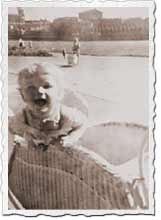Unidentified Baby
Location Unknown

Note the buildings that are important identifiers of location for residents who know this city. Regardless of specific location, the wide-open space in the background where children play and parents walk their baby carriages is seen in many cities.
This baby seems ready to lunge out of the carriage, much like many curious, eager babies. But unlike other babies, this baby’s photo was brought to Auschwitz-Birkenau, where babies had virtually no chance to survive.
Giuliana Tedeschi, a slave laborer at Auschwitz-Birkenau, devastatingly describes the image of empty prams that haunts her long after she and 49 other women were forced to push the prams waiting outside the gas chamber at Birkenau, on Sunday June 25, 1944.
Each face was stamped with a grimace of pain…. The strange procession moved forward: the mothers who had left children behind rested their hands on the push bars, instinctively feeling for the most natural position, promptly lifting the front wheels whenever they came to a bump. They saw gardens, avenues, rosy infants asleep in their carriages under vaporous pink and pale blue covers. The women who had lost children in the crematorium felt a physical longing to have a child at their breast, while seeing nothing but a long plume of smoke that drifted away to infinity….All the empty baby carriages screeched, bounced and angled into each other with the tired and desolate air of persecuted exiles.
Excerpted from Giuliana Tedeschi, There is a Place on Earth: A Woman in Birkenau, translated by Tim Parks (New York: Pantheon, 1992)
In their gripping book, Different Voices: Women and the Holocaust (Paragon, 1993), John K. Roth and Carol Ritttner ask,
“Was it an accident that women in Birkenau were assigned to move the baby carriages, a journey whose yearning and pain, grief and hopelessness, so far exceeded the hour and two miles that it took? It is hard to think so. Far more likely the mentality that created Birkenau would have reasoned precisely: “Who better than women—Jewish especially, mothers even—to move empty baby carriages from a crematorium to safekeeping for the Reich?”
This passage is not included in The Last Album: Eyes from the Ashes of Auschwitz-Birkenau, but I think of it every time I see the photos of the babies in their carriages.